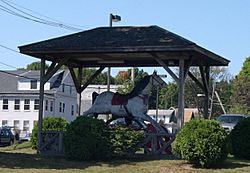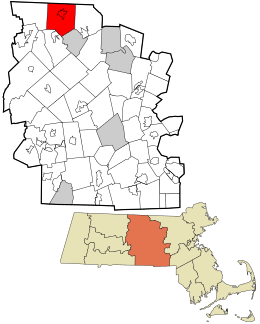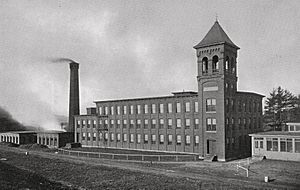Winchendon, Massachusetts facts for kids
Quick facts for kids
Winchendon, Massachusetts
|
||
|---|---|---|

Clyde II
|
||
|
||
| Nickname(s):
Toy Town
|
||

Location in Worcester County and the state of Massachusetts.
|
||
| Country | United States | |
| State | Massachusetts | |
| County | Worcester | |
| Settled | 1753 | |
| Incorporated | 1764 | |
| Government | ||
| • Type | Open town meeting | |
| Area | ||
| • Total | 44.1 sq mi (114.1 km2) | |
| • Land | 43.3 sq mi (112.1 km2) | |
| • Water | 0.8 sq mi (2.0 km2) | |
| Elevation | 1,000 ft (305 m) | |
| Population
(2020)
|
||
| • Total | 10,364 | |
| • Density | 235.01/sq mi (90.83/km2) | |
| Time zone | UTC−5 (Eastern) | |
| • Summer (DST) | UTC−4 (Eastern) | |
| ZIP Code |
01475
|
|
| Area code(s) | 351/978 | |
| FIPS code | 25-80405 | |
| GNIS feature ID | 0618394 | |
| Website | www.townofwinchendon.com | |
Winchendon is a town in Worcester County, Massachusetts, United States. It is often called "Toy Town" because of its history of making toys. In 2020, about 10,364 people lived there.
Winchendon includes smaller areas like Waterville and Winchendon Springs. You can also find the Winchendon State Forest and Otter River State Forest here. These are great places for outdoor activities.
Contents
History of Winchendon: From Forests to Toy Town
Winchendon is a small town in north-central Massachusetts. Long ago, it was the home of the Pennacook and Nipmuck Native American tribes.
How Winchendon Got Its Name
The area was first granted on June 10, 1735. This was for veterans who fought in the 1690 expeditions against Canada. Winchendon became an official town in 1764. It was named after Nether Winchendon in England. This English village was owned by Governor Francis Bernard, who signed the law making Winchendon a town.
The Millers River in Winchendon was important for powering mills. At one time, the town made so many wooden roof shingles that people called it "Shingletown."
The Story of Toy Town
Winchendon became famous for making toys. Morton E. Converse started his business in 1873. He first made wooden products, then began making toys. He teamed up with Orland Mason to form the Mason & Converse Company. Later, he started Morton E. Converse & Company.
This company made many different toys. These included Noah's Arks, doll furniture, hobby horses, drums, and building blocks. Because so many toys were made here, Winchendon earned its nickname, "Toy Town."
Clyde the Giant Rocking Horse
The first Giant Rocking Horse, named Clyde, was built in 1912 by Morton Converse. This huge, 12-foot (3.7 m) tall wooden horse was a copy of one of the company's popular rocking horses. In 1914, Clyde was part of the town's 150th-anniversary parade.
After many years, Clyde fell apart. But in 1988, a new version, Clyde II, was made by Sherman LaBarge. You can see Clyde II on display in a special pavilion today.
Spring Village: A Textile Town
Winchendon was also known for its textile industry during the Industrial Revolution. In 1843, Joseph White and his son Nelson bought a textile mill in Spring Village. By 1857, their Nelson Mills was a busy place.
Spring Village became a "company town." This meant the company provided jobs, homes, and even a school for its workers. Another mill, the Glenallan Mill, was built in 1887. The textile business did very well for many years. However, by the 1950s, most textile factories moved to the southern United States. The White Brothers, Inc. company closed in 1956.
Geography and Nature in Winchendon
Winchendon covers about 44.1 square miles (114 km2) of land and water. The Millers River flows through the town. You can find the Lake Dennison Recreation Area and Whitney Pond here. Part of Lake Monomonac is also in Winchendon, shared with Rindge, New Hampshire.
The western part of town has many marshy areas and brooks. These feed into the Millers River and Otter River. The highest point in town is the western slope of Town Line Hill. Winchendon also has parts of the Birch Hill Wildlife Management Area and the Otter River State Forest.
Winchendon is located near the New Hampshire border. It is about 16 miles (26 km) northwest of Fitchburg and 35 miles (56 km) north-northwest of Worcester.
Getting Around Winchendon: Transportation
Winchendon does not have any major highways directly in town. However, U.S. Route 202 and Route 12 pass through it. The northern end of Route 140 is also in Winchendon. This intersection was improved to make it safer for drivers.
In the past, the Boston & Albany Railroad had an important station here. Today, a bus service called Montachusett Regional Transit Authority (MART) connects Winchendon with Gardner and Fitchburg. For air travel, the closest small airport is in Templeton. Larger flights are available from Manchester-Boston Regional Airport in New Hampshire.
People of Winchendon: Demographics
In 2000, there were 9,611 people living in Winchendon. The town had 3,447 households. About 39.4% of these households had children under 18. The average household size was 2.75 people.
The population was spread out by age:
- 30.2% were under 18
- 6.6% were 18 to 24
- 32.0% were 25 to 44
- 20.7% were 45 to 64
- 10.5% were 65 or older
The average age in town was 35 years. The median income for a family was about $50,086.
Community Resources and Education
Winchendon Public Library
The Winchendon public library started in 1867. In 1907, a local businessman named Charles L. Beals gave $25,000 to build a new library. This generous gift helped create the Beals Memorial Library.
Water Supply
The Ashburnham & Winchendon Joint Water Authority provides clean water to the town. Their water comes from the spring-fed Upper Naukeag Lake in Ashburnham.
Schools in Winchendon
Winchendon has several public schools for students:
- Memorial Elementary School (Kindergarten to Grade 2)
- Toy Town Elementary School (Grades 3 to 5)
- Murdock Middle/High School (Grades 6 to 12)
Local Businesses and Attractions
Commerce
The biggest employer in Winchendon is Saloom Furniture Company. They make dining furniture and have two factories in town.
Points of Interest
There are several interesting places to visit in Winchendon:
- Murdock-Whitney House Museum: Learn about the town's history.
- Otter River State Forest: A great place for outdoor activities.
- Lake Dennison State Recreation Area: Another spot for nature and fun.
- Winchendon Music Festival: Enjoy music events in the town.
Famous People from Winchendon
Many notable people have connections to Winchendon:
- Atherton D. Converse: A politician and toy manufacturer.
- Ella Elvira Gibson: The first woman to serve as a military chaplain in the United States.
- Levi P. Morton: He was the U.S. Vice President from 1889 to 1893.
- William Barrett Washburn: Served as the Massachusetts governor from 1872 to 1874.
- Lawton Walter "Whitey" Witt: A professional baseball player in the early 1900s.
Images for kids
See also
 In Spanish: Winchendon (Massachusetts) para niños
In Spanish: Winchendon (Massachusetts) para niños











